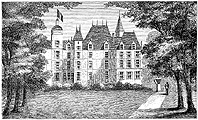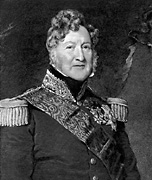The Queen Goes Visiting
One day not long ago when the Queen of England was eating her morning snack — she pretty regularly eats a morning snack — her husband stepped into her room to say good morning.
"'Morning to you too, dear," said the Queen. "God bless. What's the weather like?"
The Queen's husband bowed and said, "It looked like rain a while ago. But now it seems to be clearing up. I've had the hay raked into cocks and the hired hands can bind it even if you're not here. You're still planning to sail across today, aren't you, dear?"
"I surely am," said the Queen.
Her husband bowed again and said, "Then I'd better hurry and have the horses brought in."
"Yes, do that," said the Queen.
Now the Queen began to get dressed. She was planning to pop over to France on a visit and say hello to the King, the Queen, and various other cronies. She put on gold shoes, silver socks, a gold skirt trimmed with silver, and a gold apron. Up above she wore a silver bodice trimmed with gold and a silver cap with a gold tassel. All this gold and silver is as delicate as cobweb and lighter than gossamer, but it's warm even so. Her ladies in waiting were dressed up, too, since they were going along with her (which is the usual thing when queens go visiting).
When the Queen stepped out into the farmyard, everything was ready: horses and guides and councillors and thank-you gifts, packed in silver trunks on six horses, with a chamberlain leading each horse. There were marshalls and merchants and masses of women (besides the ladies in waiting) and grooms and horseboys galore, and everyone was dressed to the teeth. The Queen was riding Goldylock, her gilt-maned mare. He's the color of cream silk and had been imported from the deep south. Her husband rode a red saddle horse he owns himself.
"Reach me my whip, dear," said the Queen, and her husband bowed and handed her the whip. It's a gold whip with silver sockets and a platinum knob on the end.
And so off they went.
The Queen rode in front the whole way since no horse could keep up with Goldylock. When they reached the coast, the royal yacht was launched into the water. It has a silk sail and an ivory mast, screwed together and nailed with gold. The whole boat is made from horn and tortoise-shell and can move really fast.
When they had rowed out beyond the surf and the boat was heading toward open water, the Queen called back to shore three separate times, telling everyone to do a careful job with the hay (and everything else) while she was over on the other side. Then she took hold of the rudder, just for fun. It's a silver rudder, highly responsive to the touch.
The King of France lives northward along the coast on a huge and prosperous farm. His homefield is as big as The Holm in Skagafjörður,1 perfectly flat and shiny as a mirror (so the women raking hay have to wear panties under their skirts), and it has a silver wall all round it. Everyone was out haying except the King and Queen, who are beginning to feel their age. She was sitting inside in a corner of the commons room, spinning with a golden spindle, and he was sitting next to her with his crown on his head, chatting about the royal accounts and the whole farm economy.
Now one of their courtiers came into the room. (The courtiers are all princes and princesses or earls and lords-in-waiting and bishops' daughters.)
"Sieur Philippus!" he said (for the King is always called Sieur Philippus), "there's a boat out in the channel and we think it's the Queen's yacht from over on the other side. It's got a blue and red sail."
"Do you hear that, woman?" said the King. "There's company coming! I'll run down to the dock. You see to it that the place is swept out and some coffee is heated up. And you're going to have to start thinking about what to have for lunch."
"Well, I never!" said the Queen. "What a surprise! Marmier, dear," she added (for it was Marmier who had come in with the news — he was an earl now), "run out and tell little Guðmundur to hop over to the next farm for some cream."
"Where's old Guizot?" the King asked when he got outside. "I want him to come along with me. Guizot! Guizot! Where the devil has that man got to?"
But Guizot couldn't hear a word. He was lying out under the south wall, reading a seven-year-old copy of Skírnir which the Icelandic Division of the Literary Society had just sent him.
When the yacht reached shore it eased in alongside the dock (there's a dock there, just like a regular port) and the Queen of England strode ashore. The King stepped forward to meet her, doffing his crown and bowing, and she smiled and blew him a kiss. Then they hugged each other, while the Queen's husband and everyone else stood around and watched them greeting.
"Darling," said the Queen to her husband, "say hello to the King! Sieur Philippus, I brought my husband with me; I have a better time when he's along."
"Splendid!" said Sieur Philippus. "And what an unexpected honor! But come along to the farm, both of you, and have some refreshment."
So they walked toward the farm, the King taking the Queen's arm in his own and the Queen's husband and the rest of the group trotting along behind them and watching them walk arm in arm.
When they reached the homefield, no one remembered it was shiny as a mirror. The Queen was wearing such long and flowing skirts that it didn't matter. But pretty soon the other ladies were walking all hunched over, or else scrunched down on their knees. Some of them had even sat down and were pretending to tie their shoelaces. The King was the first to notice this and gave orders to spread some ashes on the field so the ladies could continue on their way. Once the ashes had been spread, everyone reached the farmhouse without difficulty.
And here I've come to the end of the page (as should be obvious). I don't know whether anyone will ever continue this story and describe their welcome at the farmhouse.
Úr gamanbréfi frá Jónasi til kunningja sinna í Kaupmannahöfn
Einu sinni á dögunum, þegar drottingin í Englandi var að borða litla skattinn — því hún borðar ævinlega litla skatt — þá kom maðurinn hennar út í skemmu að bjóða góðan dag.
"Guð gefi þér góðan dag, heillin!" sagði drottningin; "hvurnig er veðrið?"
Maðurinn drottningarinnar hneigði sig og sagði: "Hann var regnlegur í morgun, en nú birtir upp; ég lét taka saman, og svo má binda þó þú farir — ætlarð' ufrum í dag, gæska!"
"Já," sagði drottningin.
Hann hneigði sig þá aftur og sagði: "Ég verð þá að flýta mér og láta fara að sækja hestana."
"Gerðu það," segir hún.
Nú fór drottningin að búa sig, því hún ætlaði í orðlof sitt ufrá Frakkland að finna kóng og drottningu og fleiri kunningja. Hún var með gullskó, í silfursokkum og silfurbryddu gullpilsi, með gullsvuntu, og að ofan í gulllagðri silfurtreyju, með silfurhúfu og gullskúf í. En þetta gull og silfur er allt eins og ormavefur og léttara en fis og þó hlýtt. Þjónusturnar voru líka vel búnar, því þær fóru með eins og vant er þegar drottningar ferðast.
Þegar drottningin var komin út á hlað var allt tilbúið, hestarnir og fylgdarmennirnir og ráðgjafarnir og orðlofsgjafirnar — á 6 hestum í silfurkoffortum — og teymdi sinn kammerherra hvurn hest; þar voru líka í ferðinni barúnar og kaupmenn og margt kvenfólk fyrir utan þjónusturnar, og nógir meðreiðarmenn og lestamenn, og allt var vel búið. Drottningin reið "Gulltoppu," það er gullfextur færleikur, og silkibleikur á lit, og hefir verið sóttur suður í heim, en maðurinn hennar reið rauðum gæðingi, sem hann á sjálfur.
"Fáðu mér keyrið mitt, gæska!" sagði drottningin, og maðurinn hennar hneigði sig og fékk henni keyrið, það var gullkeyri með silfurhólkum og lýsigullssnúð á endanum, og svo var farið á stað.
Drottingin var alltaf á undan, því enginn hestur jafnaðist við Gulltoppu, og þegar komið var ofan að sjónum, var sett fram drottningarskipið; það er með silkisegli og fílabeinsmastri sem allt er skrúfað saman og gullneglt, allt úr horni og skelplötu, og besta gangskip.
Þegar komið var út úr landsteinunum og búið að snúa við kallaði drottningin þrisvar á land og bað að gá vel að heyjunum og öllu meðan hún væri fyrir handan; svo settist hún undir stýri að gamni sínu, en það er silfurstýri og leikur í hendi manns.
Kóngurinn í Frakkl. bjó á bestu jörðinni norður við sjó. Túnið er eins stórt og Hólmurinn í Skagafirði, rennslétt og fagurt eins og spegill — svo kvenfólkið sem rakar, verður að ganga með stuttbuxur innan undir — og silfurtúngarður allt um kring. Fólkið var allt úti við heyið, nema drottning og kóngur, sem eru gömul; hún sat inni í baðstofuhorni og var að spinna á gullsnældu, en hann sat hjá með kórónu sína, og voru þau að tala um ríkisreikningana og allan búskapinn.
Þá kom inn einn af fólkinu (en það eru allt kóngssynir og kóngsdætur, eða jarlar og kammerherrar og biskupsdætur). "Séra Filippus!" segir hann, því kóngurinn heitir séra Filippus, "það er skip á sundinu og við höldum það sé drottningarskipið að handan; seglið er blátt og rautt."
"Heyrirðu það kona!" sagð kóngurinn, "þú átt von á gestum; ég geng sjálfur ofan að sjó, en sjáðu um á meðan að verði sópað og heitt kaffe, og svo verðurðu eitthvað að hugsa fyrir miðdeginu."
"Ég er öldungis hlessa," sagði drottningin; "Marmier minn!" (því það var Marmier sem inn kom, hann er nú orðinn jarl) "farðu," segir hún, "út og láttu hann Guðmund litla hlaupa á næsta bæ eftir rjóma."
"Hvar er hann Guizot," sagði kóngurinn, þegar hann kom út, "ég ætlaði að láta hann verða mér samferða — Guizot! Guizot! hvur þremillinn er orðinn af manninum?"
En Guizot heyrði ekkert orðið; hann lá sunnan undir vegg og var að lesa 7 ára gamlan Skírnir, sem félagsdeildin á Íslandi var nýbúin að senda honum.
Þegar skipið kom að landi, renndi það upp að bryggjunni — því þar er bryggja eins og í kaupstað — og drottningin úr Englandi sté í land; kóngurinn gékk á móti henni og tók ofan kórónuna og hneigði sig, en hún kyssti á hönd sína og brosti, og svo föðmuðust þau, og maðurinn drottningarinnar og allt fólkið stóð hjá og horfði á hvurnig þau fóru að heilsast.
"Heilsaðu kónginum, gæska!" sagði drottningin; "ég tók manninn minn með mér, séra Filippus! það er skemmtilegra að hafa hann með."
"Gaman og óvænt æra!" sagði séra Filippus, "en komið þið nú heim að fá ukkur einhverja hressingu."
Svo var gengið heim og kóngurinn leiddi drt. og maðurinn drottningarinnar og allt fólkið gekk með og horfði á hvurnig þau fóru að leiðast og ganga.
Þegar kom heim á völlinn, hafði enginn munað eftir að hann var fagur eins og spegill; en fötin drottningarinnar voru svo síð að ekkert bar á, en hitt kvenfólkið gekk allt hokið og beygði sig í hnjánum, og sumar settust niður og létust vera að gera við skóinn sinn. Kóngurinn tók fyrst eftir þessu og skipaði að bera ösku á völlinn svo kvenfólkið gæti gengið heim; svo var borin aska á völlinn og svo gengu allir heim.
![]()
Blaðið er nú á enda, eins og hvur maður getur séð; ég veit ekki hvurt einhvur vill halda þessari sögu áfram og tala um viðtökurnar heima.


